Rajasthan Board RBSE Class 12 Biology Chapter 28 Man-Reproductive System
RBSE Class 12 Biology Chapter 28 Multiple Choice Questions
Question 1.
Graafian follicles are found in:
(a) Thyroid gland of a man
(b) A prostate gland of a man
(c) Ovaries of woman
(d) Testes of man
Answer:
(c) Ovaries of woman
![]()
Question 2.
Which gland secretes an alkaline fluid that helps in smoothening of the vagina at the time of mating?
(a) Prostate
(b) Rectal
(c) Cowper
(d) Perineal
Answer:
(c) Cowper
Question 3.
After how many days menstrual cycle occurs in the women.
(a) 14 days
(b) 20 days
(c) 32 days
(d) 28 days
Answer:
(d) 28 days
RBSE Class 12 Biology Chapter 28 Very Short Answer Type Questions
Question 1.
Write the function of Corpus luteum.
Answer:
Secretion of two hormones-Progesterone & Relaxin.
Question 2.
Which of the cells function as endocrine gland in the testes? Write the name of the hormone secreted by these cells.
Answer:
Leydig’s cells: Androgen hormone.
Question 3.
Write the name and function of the hormone secreted by Leydig’s cells.
Answer:
Androgen hormone.
It controls spermatogenesis & provides male secondary sexual characters.
![]()
Question 4.
Write the names of primary sex organs found in male and female human beings.
Answer:
Male – Testes
Female – Ovaries
Question 5.
Write the name of the mucous membrane found internally in the Uterus.
Answer:
Endometrium.
Question 6.
Write two secondary sexual characters of a woman.
Answer:
Well developed mammary glands.
The high pitch of voice.
RBSE Class 12 Biology Chapter 28 Short Answer Type Questions
Question 1.
What are the changes visible at the puberty in male and female human beings?
Answer:
Changes in Male and Female at Puberty:
| Male | Female |
| Growth in the penis, scrotal sacs, prostate gland and seminal vesicle. | Growth is uterus, vagina, oviducts and clitoris. |
| Beginning of spermatogenesis. | Growth of mammary glands and beginning of a menstrual cycle. |
| The low pitch of voice. | The high pitch of voice. |
| Growth of hair on face (moustache), thorax and pelvic region. | Absence of hair on the body except for pelvic region. |
| Growth of the body as a whole. | Pelvic broadening, growth of mammary glands and fat deposition in the body. |
| Secretion of testosterone, FSH, LH hormones increases. | Secretion of Progesterone, estrogen, LH hormones increases. |
| Psychological attraction towards a male. | Psychological attraction towards female. |
Question 2.
During the winter season, the scrotal sac shrinks and become small. Explain it.
Answer:
Spermatogenesis needs a temperature of 34 to 35° C. During winters, the outside temperature is low. Hence, the scrotal sacs shrink to come closure to the body to get more heat.
Question 3.
What is Cryptorchidism?
Answer:
The arrest of spermatogenesis due to high temperature is called cryptorchidism.
![]()
Question 4.
What is andropause?
Answer:
Male menopause is called andropause. there is decreased secretion of testosterone. It occurs normally after 60 years.
Question 5.
What do you mean by Sertoli cells? What are their functions?
Answer:
They are special cells which are found inside the seminiferous tubeless of testes. They provide support & nutrition to the sperms.
Question 6.
Draw a neat diagram of mammary glands of a woman and explain how it is helpful in reproductive activity.
Answer:
The mammary glands are female sexual character & are meant to secrete milk to feed young ones.
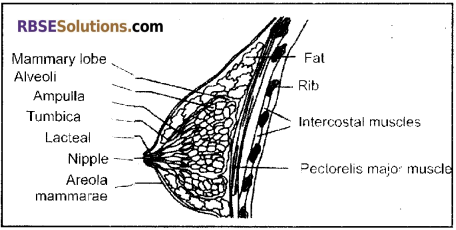
Question 7.
Draw labelled diagram of a transverse section of the testis.
Answer:
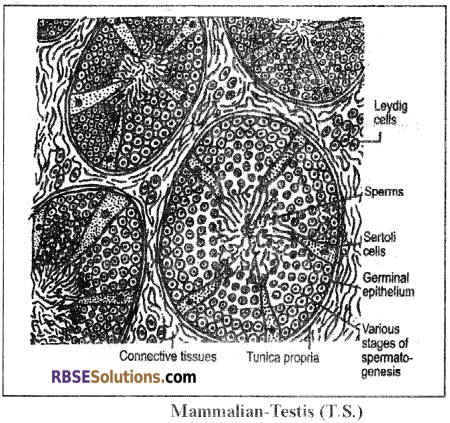
RBSE Class 12 Biology Chapter 28 Essay Type Questions
Question 1.
Describe the male reproductive system of a man with suitable diagram.
Answer:
Male Reproduction System:
- The male reproductive system consists of primary reproductive and accessory reproductive organs. Primary sex organs are a pair of testes or male gonads. Accessory reproductive organs are mainly scrotal sac, epididymis, vas deferens, penis, prostate gland and Cowper’s glands.
Testes:
- An adult man has a pair of testes (oval bodies suspended outs the body in the scrotum).
- The wall of tests is an elastic covering of thin and hairy and thick inner subcutaneous layer of unstriated muscle fibres which is known as Dartos muscle.
- In each half of scrotal sac, a tuft of rod-shaped striated muscles fibres are found. It connects the subcutaneous layer with abdominal subcutaneous muscle and known as Cremaster muscle.
- Each cavity of the scrotal sac is connected to the abdominal cavity with the help of a white Inguinal canal. In adult mammals, testes are ex-abdominal which are found outside the abdominal cavity in the testes sacs or scrotal sacs.
- The spermatogenesis in the testes: needs less temperature and the temperature of the scrotal sacs is 33 to 35°C which is 2 to 4o C less than the body temperature.
- The testis descends into the scrotal sac through an inguinal canal. The testicular artery, testicular vein & the testicular nerve also descend into the scrotal sac in the form of a spermatic cord.
- Each testis is attached in the scrotal sac with the help of a gubernaculum. Both the spermatic cord & the gubernaculum are provided with elastin fibres.
- If the testes fail to descend into the scrotal sacs, the spermatogenesis gets arrested due to a high temperature which called cryptorchidism.
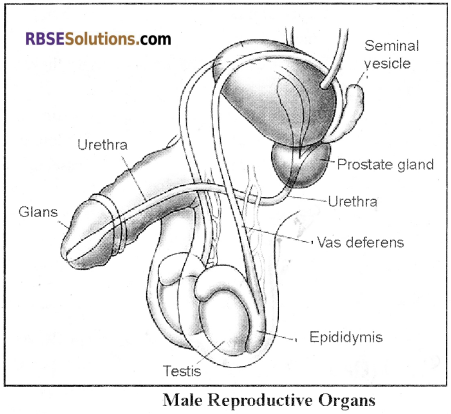
![]()
Question 2.
Explain the structure of ovary.
Answer:
Structure of Ovary:
- Ovaries are paired structures found in the abdominal cavity.
- Size of each ovary is 1.5 – 3 cm long and 8 mm thick and shape is like an almond.
- It is found behind kidneys in the pelvic region.
- Ovary forms ovum and secretes a female hormone, estrogen and progesterone.
Question 3.
Explain the role of various accessory glands in male and female helping in the reproduction process.
Answer:
(1) Accessory Glands in Male:
- Three types of accessory glands are found in man which secretes their secretions into the Urethra.
- These secretions are essential for viability and motility of spermatozoa. The secretions of accessory glands, epididymis, and sperms are collectively formed semen.
Following accessory reproductive glands are found in man –
1. Prostate Glands:
- It is situated around the anterior end of the urethra and opens into the urethra.
- The prostate gland secretes a white fluid which forms 25 – 30%part of semen.
- It is alkaline secretion and neutralizes the acidic medium of the Vagina.
- This fluid contains Phosphatase, citrate, lysozyme, fibrinolysin, spermin etc.
- It’s secretions activate the sperms and prevent the semen to coagulate.
- In aged men, the size of the prostate may be enlarged which create problem in urine discharge.
- It consists of Four lobes –
- Ventral lobe – 1
- Dorsal lobe – 1
- Lateral lobes – 2
2. Seminal Vesicles:
- It is also called as uterus masculine.
- There is a pair of seminal vesicles in man.
- The secretions of the seminal vesicle form 70% part of the seminal fluid.
- The secretions of the seminal vesicle are alkaline, slimy & its pH is 7.4. It consists of fructose, ascorbic acid, prostaglandin & enzymes.
- The fructose provides energy to the species.
3. Cowper’s glands:
- There is a pair of Cowper’s glands which are also called as Bulbo-urethral glands.
- They are small, round & yellow in colour and open into the middle part of the urethra.
- They secrete transparent & alkaline fluid having a pH 7.5 to 8. This fluid makes the urethra alkaline before the copulation
(2) Various Accessory Glands in Female:
There are two types of sex accessory glands –
- Prostate Glands:
- A pair of prostate glands open into the anterior part of the vagina. Their secretions make the vagina moist before copulation.
- Bartholin Glands:
- On both sides of the vaginal opening, a pair of bean-shaped glands are situated. These are Bartholin’s glands.
- These glands secrete an alkaline and lubricating fluid, which keeps vulva moist and facilitate sexual intercourse.
![]()
Question 4.
Write short notes on:
- Ovary
- Penis
- Epididymis
- Secondary sexual characters
- Corpus luteum
Answer:
1. Ovary:
- Ovaries are paired structures found in the abdominal cavity.
- Size of each ovary is 1.5 – 3 cm long and 8 mm thick and shape is like an almond.
- It is found behind kidneys in the pelvic region.
- Ovary forms ovum and secretes a female hormone, estrogen and progesterone.
2. Penis:
- In man, the penis is suspended between the legs along with the scrotal sacs attached to the abdomen. It is cylindrical, erectile and highly vascularized copulatory organ. It is covered by skin.
- Body of the penis is made up of three blood sinuses composed of filamentous, muscular connective tissues. Two large are dorsolateral and one is ventrally around Urethra. Dorsolateral sinuses are called corpora cavernosa and ventral sinus as corpus sporangium.
- The apex of the penis is swollen and form glans. Glans penis is a form of only corpus sporangium. Covering of skin over glans is a cap-like & called as prepuce. It gets folded on the base of glans during copulation.
- In normal condition blood, sinuses remain empty and muscles are in contraction stage, at this time only urine can flow outside through urinogenital aperture.
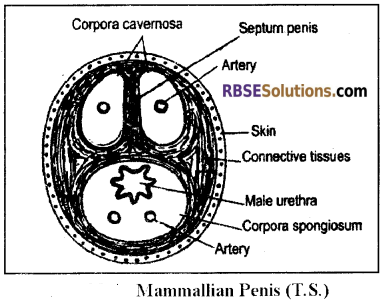
- At the time of erection or during erect position for mating, blood moves in the sinuses by penial artery, muscles relaxed and glans of the penis becomes hard and swollen as maximum as possible.
- Glans become nacked from prepuce and it is now in the erection state. The penis is ready for deep penetration in the vagina of the female. The semen ejaculated by penis into the vagina.
3. Epididymis:
- It is thin, highly coiled and comma-shaped tube about 6 meters long that leads into a vas deferens. Its coiled rings are adhered by connective tissues.
- Its outer side is covered with thick muscular layer and inner side is lined with stratified epithelium.
- It is attached to the inner surface of the testis & has 3 parts –
- Caput or globulus major
- Corpus
- Cauda or globulus minor
- Globulus major is a large cap-like structure which receives the vasa efferentia.
- Globulus minor is a small structure which opens into vas deferens.
- The epididymis stores the sperms & it is the site for physiological maturation of the sperms.
4. Secondary sexual characters:
| Male | Female |
| Growth in the penis, scrotal sacs, prostate gland and seminal vesicle. | Growth is uterus, vagina, oviducts and clitoris. |
| Beginning of spermatogenesis. | Growth of mammary glands and beginning of a menstrual cycle. |
| The low pitch of voice. | The high pitch of voice. |
| Growth of hair on face (moustache), thorax and pelvic region. | Absence of hair on the body except for pelvic region. |
| Growth of the body as a whole. | Pelvic broadening, growth of mammary glands and fat deposition in the body. |
| Secretion of testosterone, FSH, LH hormones increases. | Secretion of Progesterone, estrogen, LH hormones increases. |
| Psychological attraction towards a male. | Psychological attraction towards female. |
5. Corpus luteum:
- The follicular cells of the burst follicles reorganize under the control of LH to form corpus luteum.
- It has yellow coloured luteal cells containing lutein yellow pigments.
- This structure performs endocrine function & secretes progesterone & inhibin hormones.
- There is a blood clot in the centre of the corpus luteum which is called corpus haemorrhagic.
![]()
Question 5.
Explain with diagram the female reproductive system.
Answer:
Female Reproductive Organs:
- One pair of ovaries are found in a woman as a Primary reproductive organ.
- Accessory reproductive organs found in a female are oviducts, uterus, vagina and vulva.
- Reproductive glands and mammary glands are also included as accessory organs.
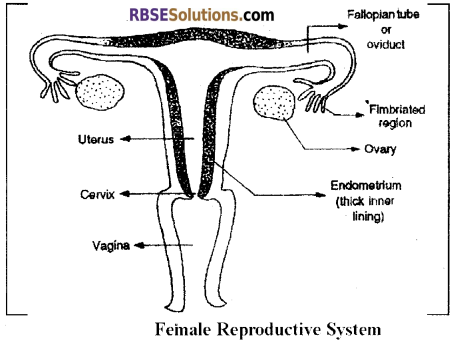
(1) Ovary:
- Ovaries are paired structures found in the abdominal cavity.
- Size of each ovary is 1.5 – 3 cm long and 8 mm thick and shape is like an almond.
- It is found behind kidneys in the pelvic region.
- Ovary forms ovum and secretes the female hormone. estrogen and progesterone.
(2) Histology of Ovary:
- There is a pair of ovaries which are attached dorsally in the abdominal cavity with the help of mesovarium. The mesovarium originates from the visceral peritoneum.
- The ovary has germinal epithelium inside the mesovarium which is made up of cuboidal germ cells.
- The ovary has stroma made up of fibrous connective tissues. The peripheral part of the stroma is condensed which is called cortex & the inner less dense part is called the medulla.
- The cortical part of the ovary has ovarian follicles which are as follows –
- Primary follicles:
- They are formed during embryonic stage & begin to grow at puberty.
- It has an oogonium surrounded by one laver of follicular cells.
- Secondary follicles:
- It has a primary oocyte surrounded by 2 layers of follicular cells.
- Tertiary follicles:
- It has primary oocyte surrounded by 3 layers of the follicular cells.
- Mature follicles or Graaffian follicles:
- It is surrounded by a membrane granulosa which consists of two layers v.z., theca external & theca internal.
- It has a fluid-filled cavity, the antrum.
- The mature follicle has a secondary oocyte which is attached to the membrane granulosa by a stalk.
- This stalk is called as germ hill or discuss proliferous or cumulus oophoritis.
- The Gryphon follicle gradually migrates to the periphery & gets protruded.
- The mature follicles bursts at the surface to release the secondary oocyte outside. It is called ovulation.
- Atretic follicle:
- Some times, the Graffian follicle fails to ovulate & degenerates gradually. The degenerating Graffian follicle is called as atretic follicle and the process is called as atresia.
- It is due to deficiency of vitamin E & by hormonal imbalance.
- Corpus luteum:
- The follicular cells of the burst follicles reorganize under the control of LH to form corpus luteum.
- It has yellow coloured luteal cells containing lutein yellow pigments.
- This structure performs endocrine function & secretes progesterone & inhibin hormones.
- There is a blood clot in the centre of the corpus luteum which is called corpus haemorrhagic.
- Corpus Albicans:
- If there is no fertilization, the corpus luteum begins to degenerate. The degenerating corpus luteum is called as corpus Albicans.
- It is colourless & non-functional.
- Primary follicles:
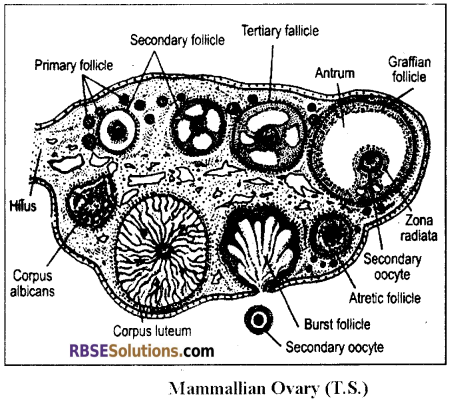
3. Oviduct:
- There is a pair of oviducts which originate from the Mullerian duct.
- The anterior end of the oviduct modified to form ciliated fimbriated funnel or infundibulum.
- Its mouth is funnelshaped which is called as ostium.
- The ovum enters into the oviduct through the oviducal funnel.
- The middle part of the oviduct is called a Fallopian tube.
- Its wall hås unstriated muscles & ciliated internally.
- The Fallopian tube is the site for secondary maturation division, fertilization & embryonic development.
4. Uterus:
- The posterior part of the oviduct modifies to for uterus.
- The uterus is simplex in a woman.
- A uterine wall has three layers –
- Epimedium:
- Outer & made up of visceral peritoneum.
- Myometrium:
- It is the middle layer which is made up of smooth muscles. It contains the longest smooth muscle.
- Endometrium:
- It is the innermost layer which has 2 layers viz., stratum functional & stratum basale.
- Epimedium:
5. Vagina:
- The large, elastic & muscular tube that runs from the cervix (terminal part of the uterus) to outside is called Vagina.
- The Vaginal opening is partially closed by a thin membrane called Hymen.
- This hymen may be torn off due to physical labour, sexual contact and exercise etc.
- Vagina provides a path for menstrual discharge beside copulatory organ of female.
- It serves as a birth canal during the birth of the child. Two folds of tissue called vulva protect the vaginal and urethral openings.
- Vaginal wall stores glycogen. The Lactobacilli bacteria present in the vagina makes mucous acidic by fermentation.
- This prevents the vagina from infection.
6. Vulva:
- The external genitalia of the woman is called vulva. It is situated just above the perineum is the pelvic area.
- Following structures are included in vulva:
- Mons pubis or Mons veneris:
- It is swollen fatty tissue covered by skin and situated above the pubic symphysis.
- Labia Majora:
- A pair of transverse folds expanded from the mons pubis to the lower side and till back. It is tissue covered by skin and hair are found on its surface.
- Labia Minora:
- There is a pair of small folds present inside the labia majora surrounding vestibule.
- Clitoris:
- It is a sensory and erectile organ situated at the anterior corner of labia minora and below the mons pubis. This is homologous to glans of the penis (intromittent organ of male).
- Vestibule:
- “A fissure like structure in the middle of labia minora is called vestibule”.
- The urinary orifice and orifice of the vagina are found. Below the clitoris is urinary orifice or meatus is found as a small aperture. Below this is orifice of the vagina is situated.
- Mons pubis or Mons veneris:
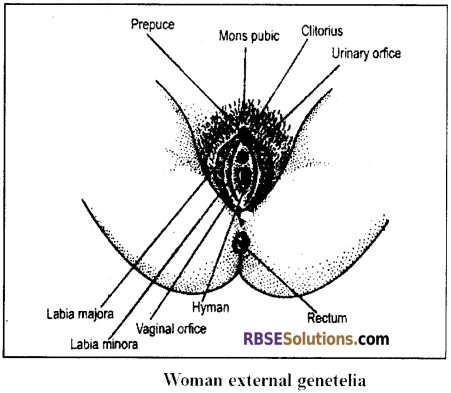
7. Sex Accessory Glands:
There are two types of sex accessory glands –
- Prostate Glands:
- A pair of prostate glands open into the anterior part of the vagina. Their secretions make the vagina moist before copulation.
- Bartholin Glands:
- On both sides of the vaginal opening, a pair of bean-shaped glands are situated. These are Bartholin’s glands.
- These glands secrete an alkaline and lubricating fluid, which keeps vulva moist and facilitate sexual intercourse.
8. Breasts:
- Breasts begin to develop at the age of puberty and finally become Mammary glands as accessory reproductive organs of the female.
- One pair of mammary glands found in women. These are found on the pectoral muscles on the ventral side.
- Each gland composed of connective tissues, 15 – 20 tubular partitioned lobules. Fatty tissue is found between these structures.
- Each lobule has a proliferation of glandular tissues caused by the action of oestrogen and progesterone.
- Glands secrete milk as the nutrition of newborn. Many small ductules unite and form lactiferous duct in each lobule.
- Such many lactiferous tubules open on the nipples independently. The nipple is a knob-like pigmented structure on each mammary gland.
- The area around the nipple is darker (dark pigmented) and called as areola mammae.
- Each nipple has 15 to 25 pores for milk ejection. Growth and function of mammary glands are controlled by somatotropin, prolactin, estrogen, progesterone and oxytocin hormones.
- Milk contains fat, lactose, casein, lysozyme, calcium, vitamin and important immunoglobins.
- Mother’s milk is a complete food for the neonatal and it develops immunity in the child.